Day 3-6: Takara-Suwanose
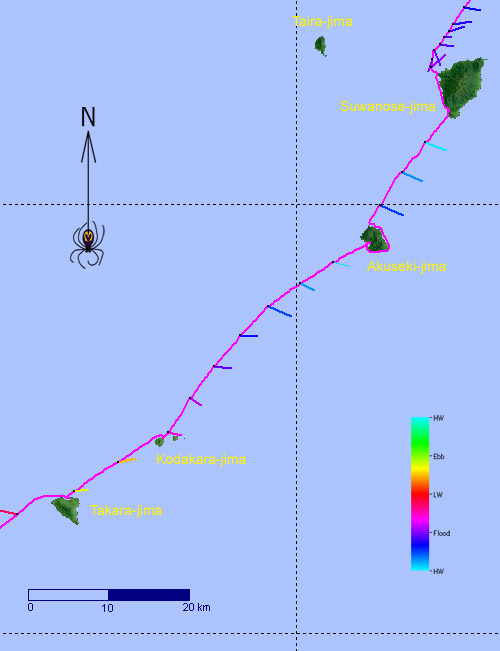
The west-to-east flow of the Kuroshio became evident on this interval, just like the forecast said it would. Speeds were up to 1.7 knots (3.2km/h) around Akuseki-jima. Normally, the currents are 2-3 knots from the north-west; these crossings would certainly be more challenging under such conditions. As it was, we had the wind and current more or less behind us, and were able to move quickly. 予想通り、黒潮の西から東への流れはこの辺で明らかになりました。流速は悪石島の付近で一番速くて1.7ノット(3.2km・h)だった。黒潮の状態は普段に変わりやすいけど、一般的に北西から南東への2-3ノットの流れです。今回幸運で追い風と良い流れのおかげで速く横断しました。
This section of the trip was perhaps our favorite. The inhabitants of the southern Tokaras were particularly friendly, welcoming us heartily, showing genuine interest (and concern) in our way of travel, and spending time with us to show us each island's unique sights. On the sea we were on our own, of course, but once landbound it felt almost like a guided tour!
We hoped it would last. On the sea, we began to feel the Kuroshio, though it usually speeded up rather than hindered our progress.
A persistently strong south-west wind blew all the way through to Akuseki, allowing us to sail much of the way in choppy to rough seas. Combined with the effect of the current, this really increased our speed; we achieved a nearly 9km/h average between Takara and Kodakara. Expecting rough water on approach to each island, we sacrificed some speed and steered upstream (left) each time but the expected races never materialized, and we actually under-shot each island (except Suwanose). But that was a small price to pay as insurance against getting washed into the open Pacific or among the enormous haystack waves for which the area is famous. It's amazing that with this wind, we never saw dangerous waves, even from a distance. On Kodakara, not knowing what was ahead, we spent a day waiting out strong winds and a rolling sea. In retrospect, we would have been okay even if we had gone that day, but our decisionmaking was sound. We did not take any major risks and the pleasure of a solidly executed travel plan feels better than a mere speed run.
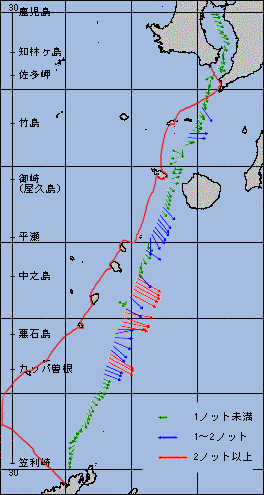
A portion of a current data chart we were consulting before and during the trip. Some of the ferries running between Kagoshima, Amami and Okinawa are equipped with current meters and their measurements are viewable on the Kagoshima Fisheries website. Data quality is good, although the time is not explicitly specified, so it is hard to account for the tidal component of the current. The ferry runs along a route different from our own track (shown in red for reference), but the current observations compare well with our own. Interestingly, the wakes of several of the islands show quite clearly on the ferry track 20km or so downstream of the islands, leading us to believe that each island leaves a long and useable wake for regaining ground should one somehow be swept too far eastward by the Kuroshio. これは鹿児島県水産技術開発センターのHPで鹿児島から奄美、那覇、甑へ就航している定期客船で観測した流れのデータを示すグラフです。情報の質が良いが、計った時間が載ってないので潮流の影響がわかりにくい。定期客船と僕たちの(赤線で示している)航路が大分違うが、流れの測定の結果を比べると、主に大きく変わらない。フェリーのデータを細かく見ると島から20キロ下流でもその影が見えます。もし黒潮に東に流されたらこの影を利用して島に戻れる可能性があるだろう。
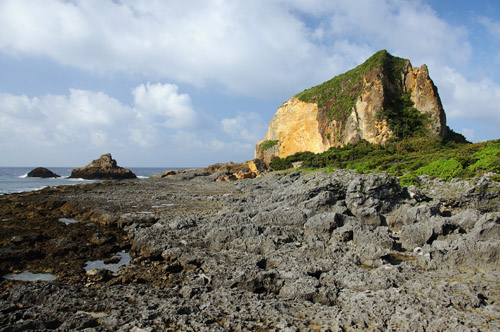
Like Takara-jima, Kodakara too has a rampart reef embedded with tall pinnacles like this one. By its base and invisible in this picture, a swimming-pool-size artificial lagoon was blasted out of the reef, making playing in the sea accessible for local children. Currents, waves, and sharp rocks on the coastline make the sea otherwise off limits to all but very experienced swimmmers. 宝島と小宝島も同じ地形で珊瑚礁からピナクルがあちこち出ている。こちらの「赤立神」の麓でプールのサイズの人工的な海跡湖が出来ている。島の海岸の周りの流れ・波・鋭い岩の為泳ぎにくいから、地元の子供のために作られたプールです。
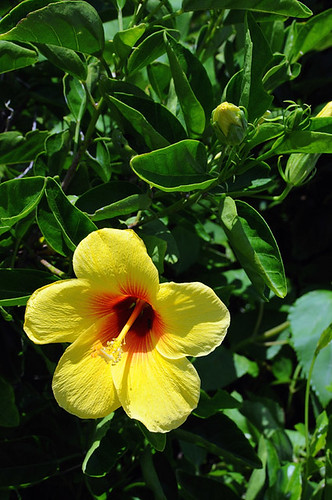
This yellow variety of hibiscus was ubiquitous in Tokara, contributing to the distinctive feel of the islands' natural environment. この黄色ハイビスカス(黄蜀葵)がトカラで代表です。島の特別な自然な環境の観照に増やしてくれた。
宝島から諏訪瀬島まではこの旅の中で一番楽しかった部分でした。出会った島民が特に優しくて親切でした。僕たちの旅について本当に興味と懸念を持っていて、車で島の案内もしてくれました。海では独行で動いたが上陸するとツアーに参加しているの感じでした。海ではやっと黒潮を感じていたが航海に悪い影響がなかった。悪石島まで絶えることなく強い南西の風が吹いていた。そこまで荒波でもずっとウインドパドルを使って快走した。追い流れと風の為宝島から小宝島までの横断では平均速度9km・hに近づいた。 島を近寄ったら三角波が立つと思ったので避ける為に左へ溯上したが余り激潮が無かった。実は諏訪瀬島以外に島を避け過ぎました。でもどうしようもなかった。もしデッカイ三角波に会ったら大変な事になるでしょう。最悪の場合太平洋に流されてしまう。
小宝島で強い風と荒れた海の為に一日停滞した。回顧的に考えると行っても大丈夫かもしれないが休んでもよかったと思う。旅はのんびりして、リスクを出来れば少なくして、島の風景を楽しめる。
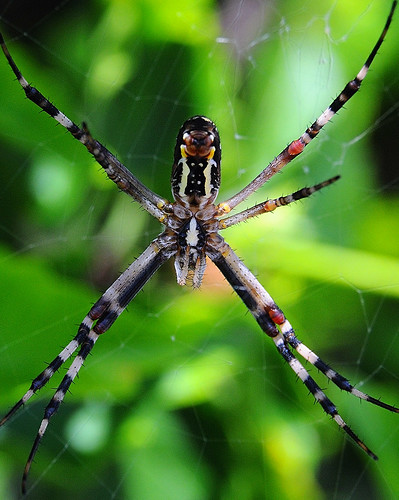
Spiders rule the late summer in southwest Japan, gradually growing in size as they feast on abundant insect life. Even near our home, one cannot go hiking in the fall without vigorously swinging a stick around to clear the huge and resilient webs off the trail. In Tokara, the spiders were one or two months ahead of Kyushu in size. This one was already about 5cm; we wonder how big he will get in October? 晩夏は蜘蛛が虫の世界を支配する季節です。
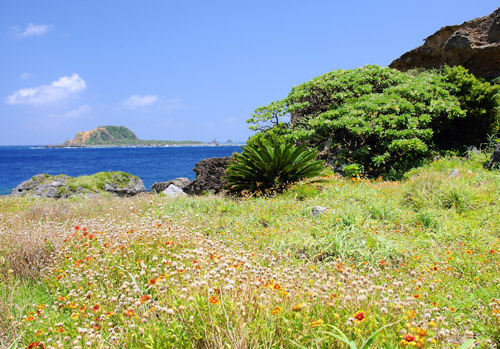
The aptly named Kodakara-jima, or Little Treasure Island, is small enough to walk around comfortably, offering enjoyable scenery around every corner. This and nearby Treasure Island's Mediterranean hues differ in character from the abundantly rich greens of the rest of the Tokaras. Nearby Kojima and other reefs (visible in the background) reportedly have first-class snorkeling and fishing; tropical species such as the giant Napoleon Fish are to be seen. 小宝島は名前通り小さくて気楽に一周を歩けます。宝島と小宝島は景色がどこでも美しくて、景色は中々地中海の島に似ている。
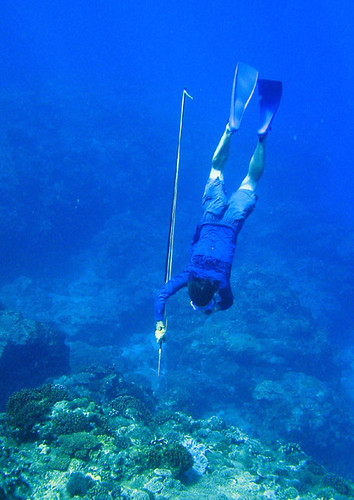
We explored the reefs on the lee side of Kodakara while waiting out a windy day. Notable was the abundance of sea-snakes of all sizes; we were told that this is their breeding ground. Rick spent several hours spearfishing in the crystal clear water, but the fish outsmarted him this time. With labyrinthine caves and crevices in the limestone reef into which the fish can and do escape, a snorkeling hunter has very little chance of success. Because of the presence of reef sharks, the fish are also a lot warier of human-size creatures than they are at our home base of Amakusa.
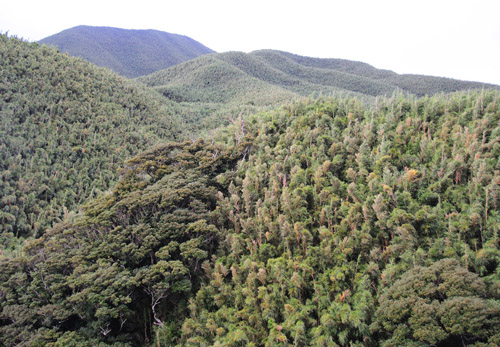
The breeze ripples the forest of dense bamboo forest that covers the high ground of Akuseki-jima, giving it a deservedly desolate appearance. Our new friend Mr. Higo the fisherman drove us all around the island. He dreams of someday visiting Canada and seeing the scenery of the Rocky Mountains. Meanwhile our own jaws drop on the spectacular sight of these lonely islands scattered across the deep indigo sea. 悪石島の竹山が薫風で踊っていた感じがした。
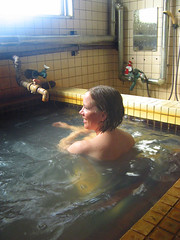
On this volcanic island chain, geothermal springs are the norm and many simple but authentic spas can be enjoyed free of charge, though perhaps the tropical summer is not the right time for such a tour. Leanne, whose body seems to generate very little intrinsic heat, didn't think so I guess. この暑い天気でも里杏は温泉を楽しめる。
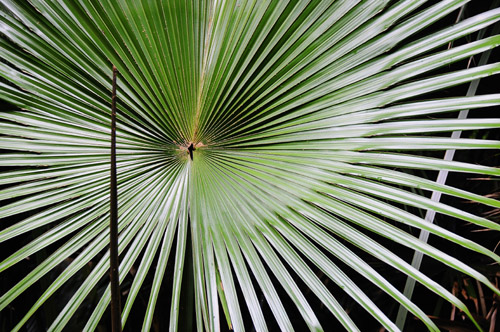
Mr. Higo pointed out to us a nature trail that led through the sub-tropical foliage of a thick, dark jungle. The distinctive leaves of the Chinese fan palm particularly caught the eye. 悪石島のジャングルにてビロウの葉っぱが目立ちました。


2 Comments:
Hello, I've found your pages the most informative about a very unknown group of Islands. Thank you. I live in Okinawa, also teach. I'm planning a trip there in the spring. Best wishes, Robert
By Unknown, at 11:45 am
Unknown, at 11:45 am
hello. we love the tokara islands as well as all the wonderful islands in Okinawa. Please say hi to all our buddies when you go there in the spring. i highly recommend traveling to these islands. I am sure you will not be disappointed!
By Leanne and Rik Brezina, at 10:56 pm
Leanne and Rik Brezina, at 10:56 pm
Post a Comment
<< Home